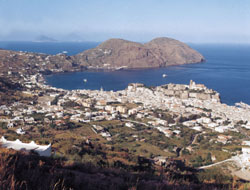
L. Bernabò Brea, M. Cavalier - Meligunýs LipÓra I
La stazione preistorica della contrada Diana. La necropoli protostorica di Lipari, Palermo, 1960.
This volume marks the beginning of the publication of the archaeological excavations conducted by the Soprintendenza alle AntichitÓ della Sicilia Orientale in the Aeolian Isles.
In the Neolithic period the prosperity of these islands depended on the exploitation of one of the raw materials then most in demand: obsidian, the natural volcanic glass with a very sharp cutting edge erupted by the volcanoes of Lipari. Obsidian could be shaped into effective cutting tools and was widely exported. The island grew rich on this trade and became populated with flourishing villages. These settlements included, towards the end of the Neolithic period, that of the Contrada Diana, which is described in the first part of this book.
Thanks to these discoveries, the Aeolian Neolithic is revealed as a very sophisticated civilization endowed with an advanced artistic sensibility, especially expressed in the elegant forms of vases and in the perfect smoothing of their monochrome surfaces.
With the spread of metal technology, the demand for obsidian declined and the Aeolian Isles felt the economic consequences of the changed conditions of life; this was a period of transition from the Neolithic to the age of metals. Renato Peroni says: "Meligunýs LipÓra I gives us in the first place a complete definition and a reliable classification of the Diana culture".
The second part of the book describes the tombs, with their rich grave goods of bronze, amber, glass paste and gold, of the Ausonian conquerors of the islands. They brought with them the rite of inhumation. This is an important contribution to our knowledge of the end of the Bronze Age in Italy, which Renato Peroni regards as a "great step forwards in our historical understanding of this period".
